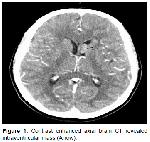SCLC accounts for about 16-20% of lung carcinomas
1. It has the most aggressive clinical course from pulmonary tumor types and has an average survival ofonly 2 to 4 months after diagnosis. Symptoms can be seen from local invasion or compression of adjacent thoracic structures, esophageal compression causing dysphagia, compression to the laryngeal nerves causing hoarseness, or compression to the superior vena cava may lead facial edema and distension of the superficial veins of neck and head. Symptoms may also be present from distant metastases and include neurologic deficit or personality changes duo to brain metastases or pain duo to bone metastases.
Brain metastasis is the most common intracranial neoplasia, seen in 8-10% of cancer cases. It is an important cause of cancer-related morbidity and mortality in the world.
SCLC has increased risk for early hematogeneous spread, especially to the brain (3).
Brain metastases are present in 24% of patients when brain MRI is included during the staging evaluation (4, 5). If most patients live long enough, brain metastasis will eventually develop. Parenchymal metastases are more frequent, but intraventricular spread of SCLC is rare 2.
In general, intraventricular spread from epithelial malignancies occurs in less than 5% of cancer patients. Kidney, breast, gastric, pituitary, thyroid or bladder carcinomas, lung or colon adenocarcinomas, lymphomas and melanomas can be made metastasis 6. These patients will not have a chance for any radical therapy. Most of them will survive only one month or less without any treatment 7. Treatment options for patients are determined by histology, stage, general health and patient comorbidity.
Radiotherapy may improve neurocognitive function shortly after treatment in a particular group of patients with neurological disorders. Prophylactic cranial irradiation (PCI) is now part of the standard treatment 8




